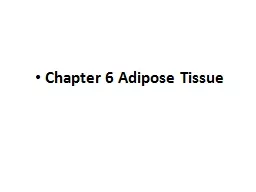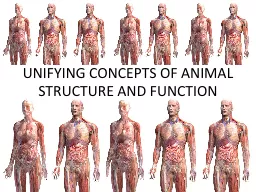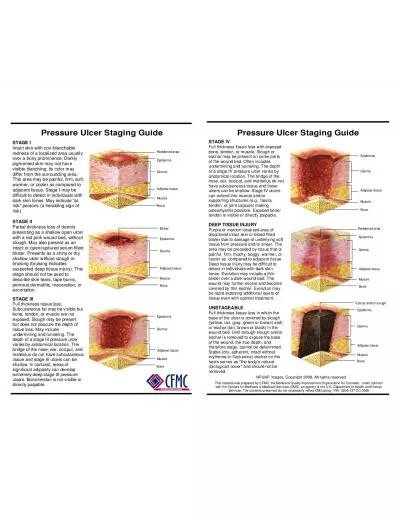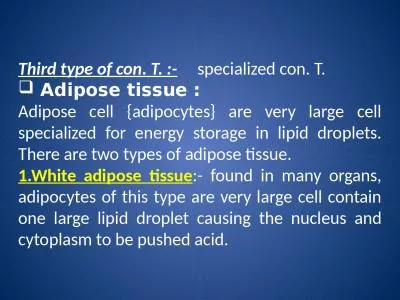PPT-ADIPOSE TISSUE STRUCTURE;TYPES; AND FUNCTION
Author : olivia-moreira | Published Date : 2020-01-31
ADIPOSE TISSUE STRUCTURETYPES AND FUNCTION WHAT IS ADIPOSE TISSUE Adipose tissue or fat is an anatomical term for loose connective tissue composed of adipocytes
Presentation Embed Code
Download Presentation
Download Presentation The PPT/PDF document "ADIPOSE TISSUE STRUCTURE;TYPES; AND FUNC..." is the property of its rightful owner. Permission is granted to download and print the materials on this website for personal, non-commercial use only, and to display it on your personal computer provided you do not modify the materials and that you retain all copyright notices contained in the materials. By downloading content from our website, you accept the terms of this agreement.
ADIPOSE TISSUE STRUCTURE;TYPES; AND FUNCTION: Transcript
ADIPOSE TISSUE STRUCTURETYPES AND FUNCTION WHAT IS ADIPOSE TISSUE Adipose tissue or fat is an anatomical term for loose connective tissue composed of adipocytes Its main role is to store energy in the form of fat although it also cushions and insulates the body. Tissue. Digital Laboratory. It’s best to view this in . Slide Show . mode, especially for the quizzes.. This module will take approximately 30 minutes to complete.. After completing this exercise, you should be able to:. A . specialized type of connective tissue in . which . adipocytes. . or fat cells predominate.. Located . in many areas throughout the body, . A. dipose . tissue represents 15–20% of the body weight in men.. CONNECTIVE TISSUE. Connective tissue is one of the basic tissues which gives structural and metabolic support to the organ and other tissue of the body.. It connects other tissues.. . Edited by: Jessica Hawley. Compiled by Mark Anderson. Classify different tissues by their shape and number. Know the four different . types of . tissues. Compare and contrast different functions of tissues. UNIFYING CONCEPTS IN ANIMAL STRUCTURE AND FUNCTION. STRUCTURE FITS FUNCTION IN THE ANIMAL BODY. ANATOMY. DEF . . THE STUDY OF THE STRUCTURE OF AN ORGANISM. PHYSIOLOGY. DEF . . THE STUDY OF THE FUNCTIONS AN ORGANISM PERFORMS. Obesity Pathophysiology. Obesity Has Multiple Pathophysiologic Origins. 2. Bray GA, et al. . Lancet. . 2016;387:1947-1956.. Obesity. Epigenetic. Genetic. Physiologic. Behavioral. Sociocultural. Environmental. renal . capsule. . . You should also notice a “pinched-in” area where the renal blood vessels and . ureter. are attached to the kidney.. This is the renal . hilus. .. Remove the renal capsule. Once the renal capsule is removed, you will be looking at the renal cortex (if you would remove the renal . 137748 Applied Biochemistry in Nutritional Science. Email: anusornc@kku.ac.th. E-learning: . http://ags.kku.ac.th/eLearning/137748. . . . Metabolism of Nutrients in Muscle and Adipose Tissue. Introduction. Their usage in regenerative medicine and transformation into beta like cells. By Evelina Cohn. Macroscopically, at least 5 different types of adipose . tissue exist. : bone marrow, brown, mammary, mechanical, . Dr. Vasiliki E Kalodimou. , . Head of Flow Cytometry-Research and Regenerative Medicine Department, . IASO-Maternity Hospital, Athens-Greece . E-mail: . kalodimou@yahoo.gr. Adipose-derived stem cells (ADSCs), represents a promising approach to future cell-based therapies. These cells can be readily harvested in large numbers with low donor-site morbidity.. hours to or more (SMITH 1962b, & SMITH 1964). INTERSCAPULAR SUBCUZ VENTRAL SUBCUT. 0 0 .~L/___..~7~. [~.~, - I 0 , , brown adipose tissue during cold-induced arousaI deep hibernation. of brown & SMITH STAGE I Intact skin with non-blanchable redness of a localized area usually over a bony prominence. Darkly pigmented skin may not have visible blanching; its color may differ from the surrounding are Stem Cell Treatment . T. eam of San Antonio. Multipotent stem cells are richly present in fat tissue.. Extensive proliferative capacity.. Ability to differentiate.. Stem Cells. How is Micro-Fragmented Adipose Tissue Created?. specialized con. T. . Adipose tissue :. Adipose cell {adipocytes} are very large cell specialized for energy storage in lipid droplets. There are two types of adipose tissue. . 1.White adipose tissue.
Download Document
Here is the link to download the presentation.
"ADIPOSE TISSUE STRUCTURE;TYPES; AND FUNCTION"The content belongs to its owner. You may download and print it for personal use, without modification, and keep all copyright notices. By downloading, you agree to these terms.
Related Documents














